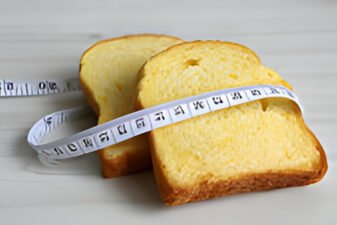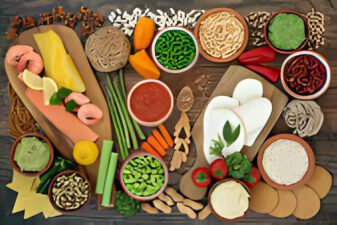As we have seen (How Carbs are Digested) the speed at which carbohydrate is broken down in the intestinal tract into simple sugars and ultimately glucose, is usually dependent on the specific structure of the carb in question (meaning: how easy is it for the digestive enzymes to gain access to the carbohydrate) but can also be affected by other factors which interfere with the action of enzymes.
Physical Structure
The physical characteristics of the carbohydrate is a major factor in determining its likely GI value.
- The small particle size of finely ground flour gives digestive enzymes great surface area to attack and metabolize the bread. By comparison, stone-ground flour has a larger particle size and consequently a lower GI value.
- A “puffed up” or “swollen” carbohydrate is more rapidly metabolized to glucose and has a higher GI value than less enlarged carbs. For example, fluffy white bread typically has a much higher GI value than denser rye breads.
- A carbohydrate surrounded by fiber, like that in vegetables, beans, nuts and seeds, is better protected from rapid attack by digestive enzymes and has a lower GI value than other carbohydrates.
- Very refined carbs (eg. many breakfast cereals) typically have most of their ‘natural’ fiber and other indigestible constituents removed. Result? These carbs tend to be rapidly metabolized into glucose.
Molecular Structure
Carbs with a simple molecular structure, like monosaccharides, are metabolized to glucose much more rapidly than more complex polysaccharides.
Starches
An interesting example of how a carb’s chemical structure can affect GI rating is seen in various starches. Starch comes in two forms, amylose and amylopectin. Starchy carbs typically contain a mixture of the two types, but the molecular structure of amylose is tighter and more compact, thus less easy to breakdown than amylopectin, whose structure is more extended and more vulnerable to attack from digestive enzymes. Thus, carbohydrates like beans, lentils, basmati rice with a high ratio of amylose-to-amylopectin tend to have lower GI values.
Other Factors That Influence GI Rating
Cooking
Pasta has a medium-glycemic-index value of 40-50. This may be lowered by cooking it for less time (al dente). Al dente pasta resists the effect of digestive enzymes more than regular cooked pasta and so has a lower GI.
Presence of Soluble Fiber in the Gut
Soluble fiber in the stomach or small intestine inhibits interaction between carbohydrate and the digestive enzymes, whose job is to break down the carb into glucose. One reason why it’s a good idea to include a high fiber food with every meal. It helps reduce the GI value of the meal.
Presence of Acid
Acid in the stomach during digestion (eg. in the form of lemon juice) tends to slow down stomach emptying and thus the conversion of carbs to glucose.
Presence of Fat
The same applies to fat. Like acid, fat retards stomach emptying and thus glucose metabolism. This explains why certain candy bars have relatively low GI values, despite their refined nature and simple physical structures.
Presence of Sugar
A concentration of sugar in the stomach and intestine typically inhibits the effects of digestive enzymes, as it attracts water which would otherwise help in glucose metabolism.










